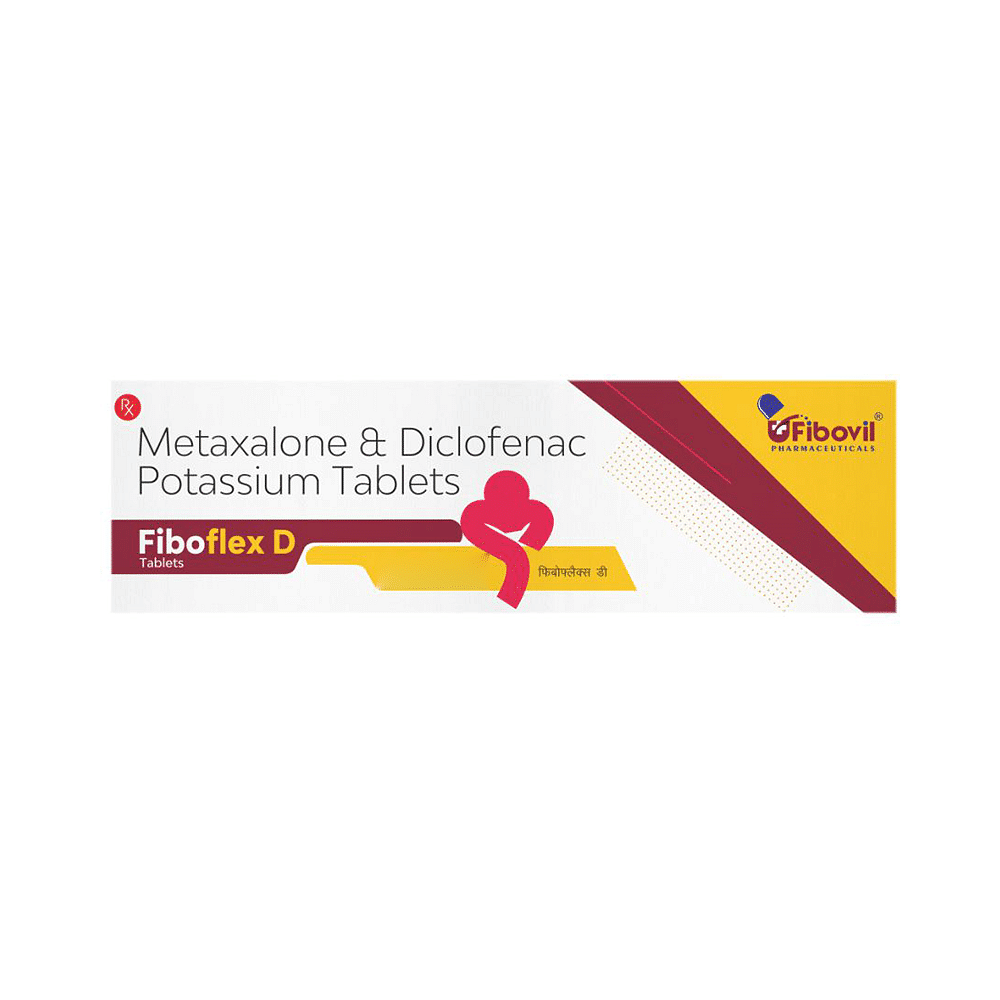
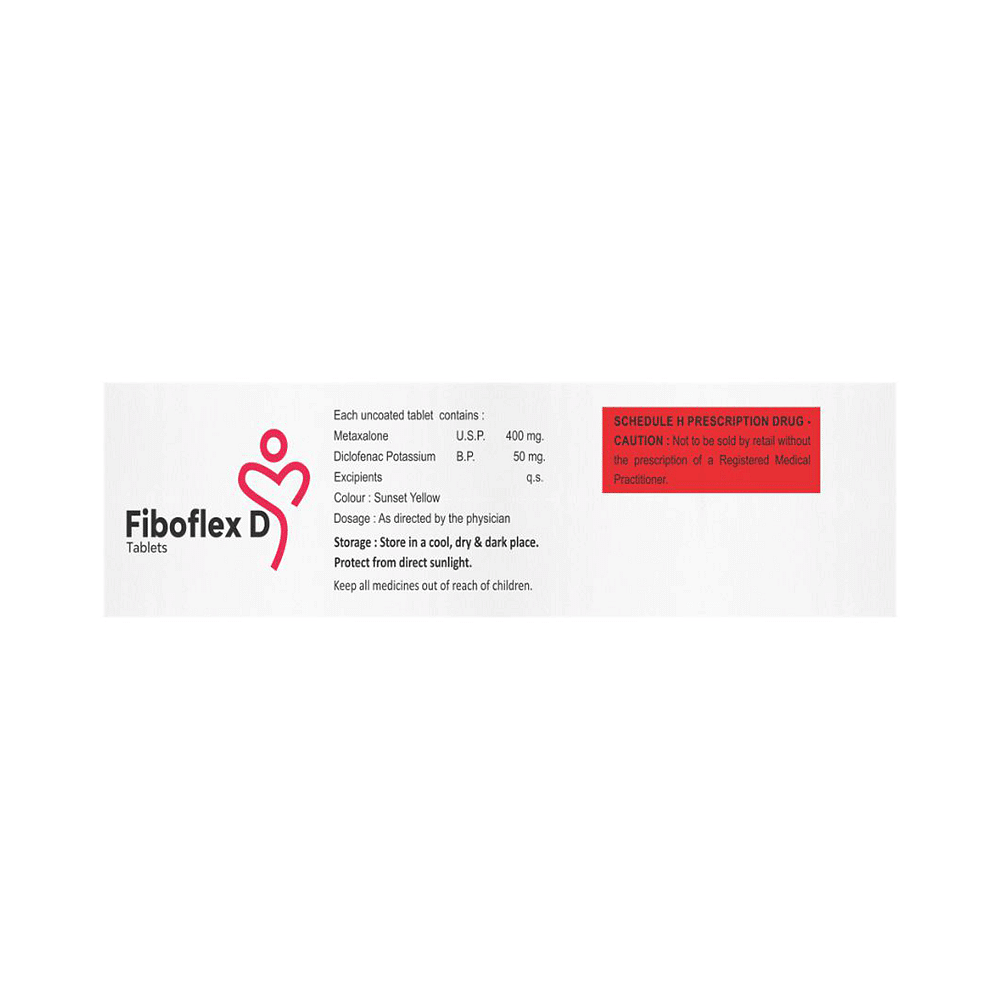
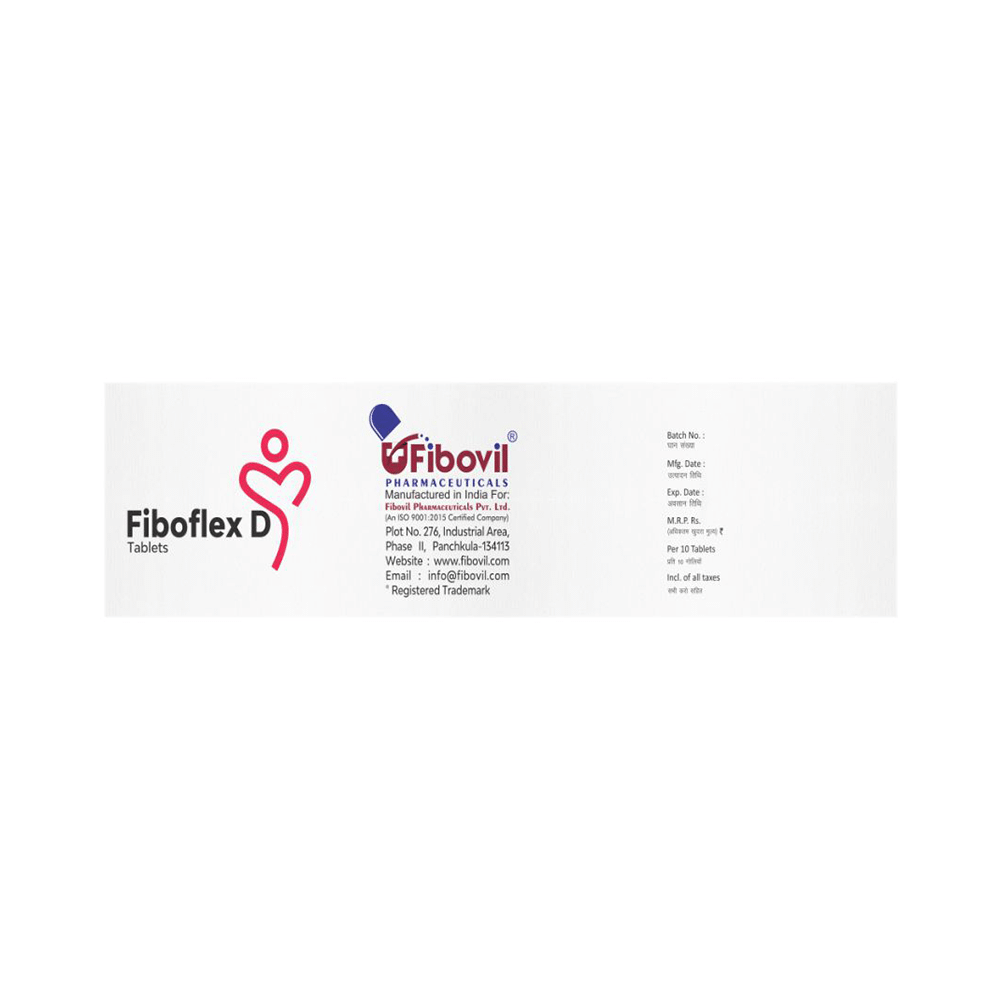
Fiboflex D Tablet
Manufacturer
Fibovil Pharmaceuticals Pvt Ltd
Salt Composition
Diclofenac (50mg) + Metaxalone (400mg)
Key Information
Short Description
Fiboflex D Tablet is a combination medicine used in the treatment of pain due to muscle spasms. It improves the movement of muscles and provides relief from pain and discomfort associated with muscle spasms.
Dosage Form
Tablet
Introduction
Fiboflex D Tablet is best taken on an empty stomach. You should take it regularly as advised by your doctor. Do not take more or use it for a longer duration than recommended by your doctor. Some common side effects of this medicine include nausea, vomiting, stomach pain, heartburn, diarrhea, sleepiness, and loss of appetite. If any of these side effects bother you or do not go away with time, you should let your doctor know. Your doctor may help with ways to reduce or prevent these side effects. The medicine may not be suitable for everybody. Before taking it, let your doctor know if you have any problems with your heart, kidneys, and liver. To make sure it is safe for you, let your doctor also know all the other medicines you are taking. Pregnant and breastfeeding mothers should first consult their doctors before using the medicine.
Directions for Use
Take this medicine in the dose and duration as advised by your doctor. Swallow it as a whole. Do not chew, crush, or break it. Fiboflex D Tablet is to be taken on an empty stomach.
How it works
Fiboflex D Tablet is a combination of two medicines: Diclofenac and Metaxalone, which relieves pain and relaxes the muscles. Diclofenac is a non-steroidal anti-inflammatory drug (NSAID) which works by blocking the release of certain chemical messengers that cause pain and inflammation (redness and swelling). Metaxalone is a muscle relaxant. It works on the centers in the brain and spinal cord to relieve muscle stiffness or spasm. It relieves pain and improves the movement of muscles.
Quick Tips
Fiboflex D Tablet helps relieve pain and muscle spasm that may occur due to strains, sprains, and muscle injuries. It is usually used along with rest and physical therapy. It may cause dizziness. Do not drive or do anything requiring concentration until you know how it affects you. Avoid consuming alcohol when taking Fiboflex D Tablet as it may cause excessive drowsiness.
Related Medicines

Myospaz D Tablet

Mobiswift-D Tablet
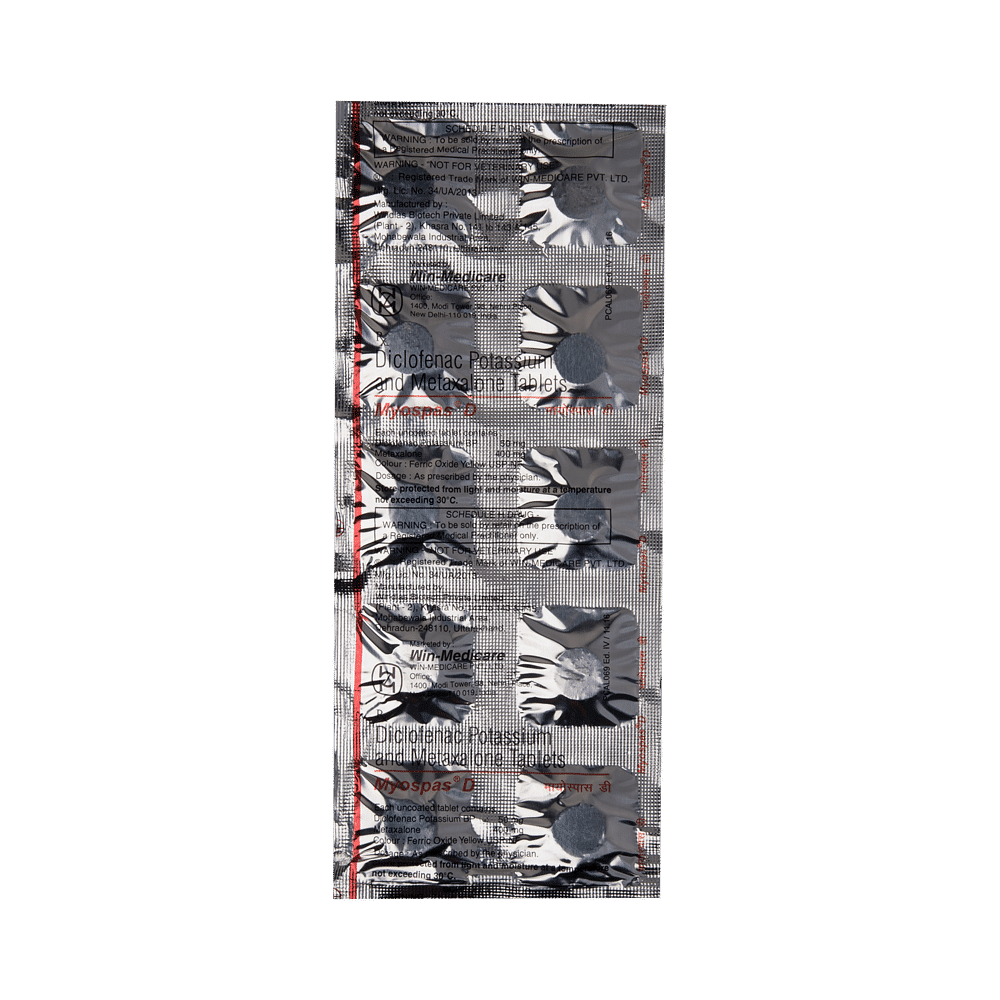
Myospas D Tablet
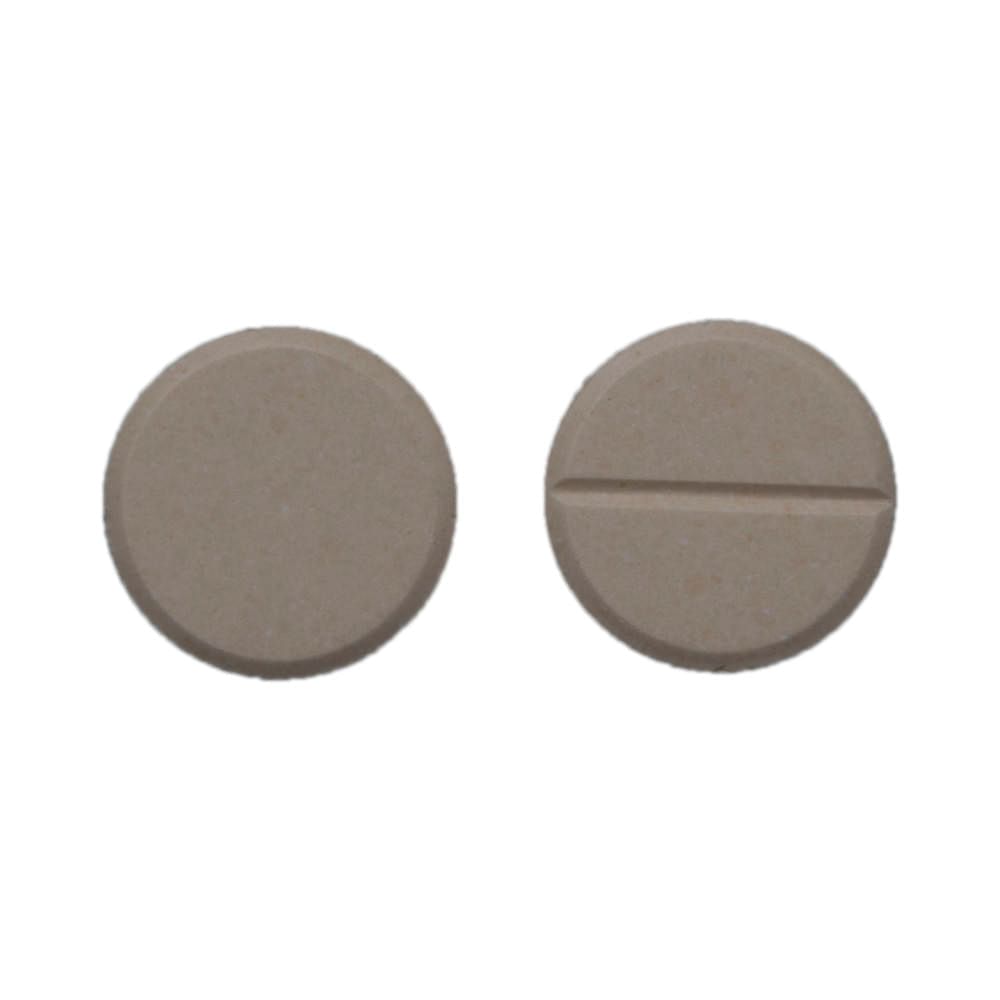
Flexura D Tablet

Maxaflax D 50mg/400mg Tablet

Metazan D 50mg/400mg Tablet

Alameta D 50mg/400mg Tablet

Metaxone D 50mg/400mg Tablet

Flexirest-D Tablet

Caredic-M Tablet
Frequently asked questions
What is Fiboflex D Tablet?
Fiboflex D Tablet contains two active ingredients: diclofenac and metaxalone. This combination relieves muscle pain by relaxing muscles through its action on the central nervous system and lowering chemical substances in the body that contribute to pain and inflammation.
Can I stop taking Fiboflex D Tablet when my pain is relieved?
Fiboflex D Tablet is usually used for short-term relief and should be discontinued once your pain subsides. However, your doctor may advise you to continue the medication.
Can Fiboflex D Tablet cause nausea and vomiting?
Yes, some people experience nausea and vomiting when taking Fiboflex D Tablet. Taking it with milk, food, or antacids can help prevent these side effects. Avoid fatty or fried foods while using this medication. If you experience persistent vomiting, drink plenty of water or other fluids. Consult your doctor if vomiting persists and notice signs of dehydration like dark-colored and strong-smelling urine and reduced urination frequency. Do not take any other medicine without consulting your doctor.
Can Fiboflex D Tablet cause dizziness?
Yes, some patients may experience dizziness (feeling faint, weak, unsteady or lightheaded) while taking Fiboflex D Tablet. If you feel dizzy, rest for a while and resume once feeling better.
Are there any specific contraindications associated with using Fiboflex D Tablet?
Fiboflex D Tablet is not recommended for individuals with known allergies to pain relievers (NSAIDs) or any of its components or excipients. It should be avoided in patients with a history of stomach ulcers, active or recurrent stomach ulcer/bleeding. This medication should also be avoided in patients with a history of heart failure, high blood pressure, or underlying liver or kidney disease.
Can the use of Fiboflex D Tablet damage to kidneys?
Long-term use of Fiboflex D Tablet can lead to kidney damage. Prostaglandins, a chemical produced by normal kidneys, protect them from damage. Painkillers lower prostaglandin levels in the body, leading to long-term kidney damage if used for prolonged periods. Use of painkillers is not recommended in individuals with pre-existing kidney disease.
Can I take a higher dose of this medicine than recommended?
Taking a higher dose of Fiboflex D Tablet can increase the likelihood of side effects. If you're experiencing increased pain or your pain isn't relieved by the prescribed dosage, consult your doctor for re-evaluation.
What is the recommended storage condition for Fiboflex D Tablet?
Store Fiboflex D Tablet in its original container or packaging, tightly closed. Follow the instructions on the medication label regarding storage and disposal. Ensure that the medication is inaccessible to pets, children, and other individuals.


